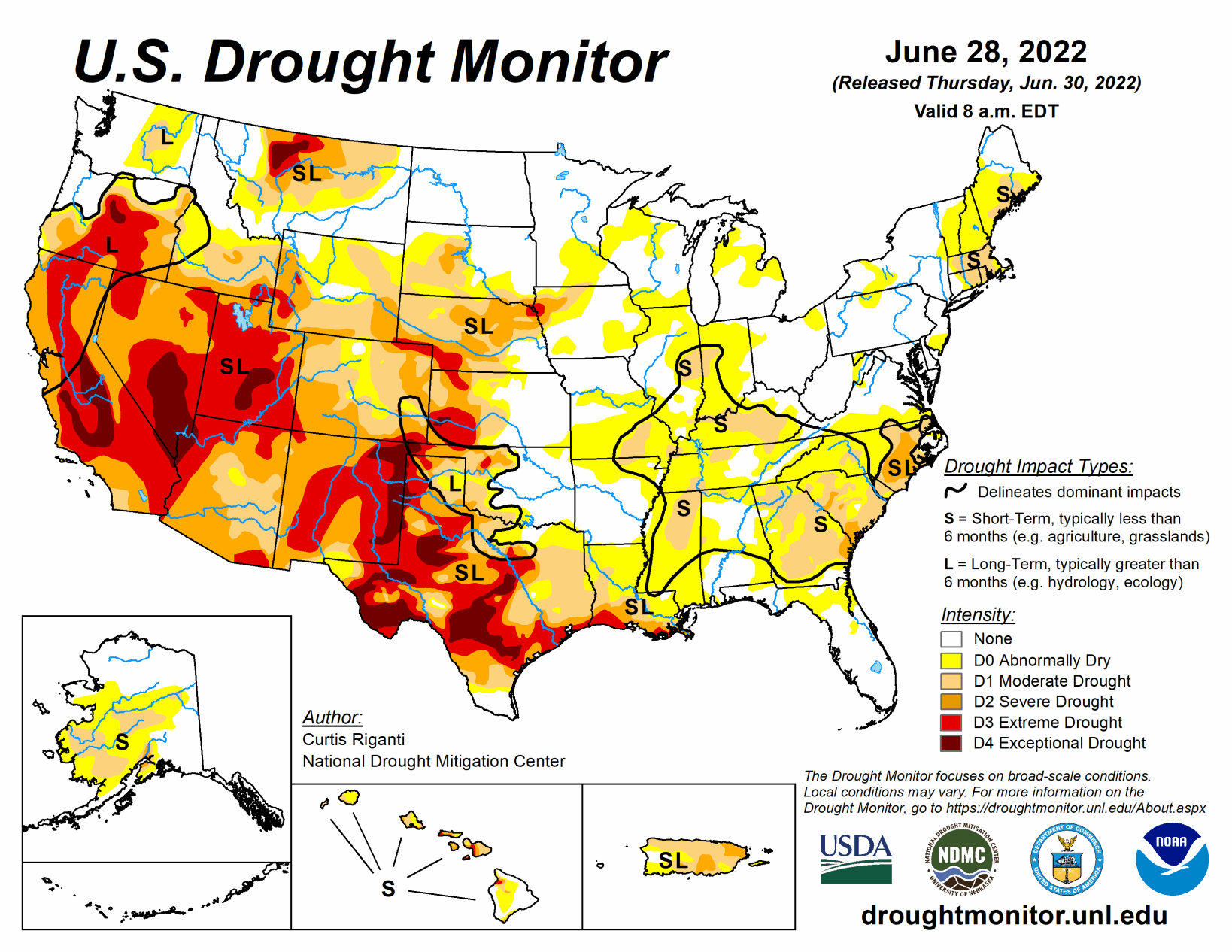Widespread moderate drought and abnormal dryness continued to form and expand across a large swath of the eastern U.S. this week, with a few areas of severe drought forming or expanding as well. Spotty rain and storms occurred across the East, but in areas that missed out on heavy rainfall, high temperatures, browning lawns, and curling corn signaled that rapid drying was taking place in many areas.
An early start to the North American Monsoon, particularly in New Mexico and southern Colorado, led to widespread improvement of extreme and exceptional drought in those states. Extreme drought formed or expanded in parts of the central Great Plains this week, where warm, dry weather continued. Despite some improvements to conditions in parts of the West, severe, extreme, and some exceptional drought remains widespread there.
South
Mainly dry conditions prevailed in the South this week, particularly from central Oklahoma and northeast Texas through Arkansas. Elsewhere, conditions were mostly dry, though some areas of heavier precipitation fell locally. Precipitation deficits improved enough in parts of western Oklahoma and the Texas Panhandle for some limited improvements to long-term drought conditions. Elsewhere, conditions mostly stayed the same or degraded, and abnormal dryness and moderate short-term drought quickly became entrenched in parts of east Texas, northern Louisiana, northern Arkansas, northern Mississippi, and Tennessee. Severe and extreme short- and long-term drought continued to plague southern Louisiana and a large portion of Texas this week. In drought areas in Texas, soil moisture deficits and low streamflow remained a major impact this week. There, extreme heat made drought-related problems worse. White-tailed deer are expected to have lower antler quality this fall in Texas due to the conditions. Additionally, crop stress continued and stock tanks lowered.
Midwest
Some heavier rains fell across parts of the Midwest this week, especially in eastern Iowa and northern Minnesota. For areas that missed out, similar to the Southeast region, rapid drying is occurring in the short-term, leading to widespread introduction of abnormal dryness and short-term moderate drought. This week, short-term moderate drought was introduced or expanded across much of central Kentucky, the Illinois-Indiana border, and southeast Missouri. Parts of Kentucky are seeing corn leaves curl as a result of the recent hot and dry weather.
High Plains
Extreme drought developed in far northeast Nebraska, and in adjacent portions of South Dakota and Iowa, near the Sioux City area. Here, on the short- and long-term precipitation deficits have combined with high evaporation rates to create significant soil moisture and groundwater shortages, which have recently been reported. Severe and extreme drought also expanded across northeast and central Colorado, southeast Wyoming, and parts of southwest Nebraska, where dry weather continued.
North Platte, Nebraska, may tie its second driest June on record, with 0.43 inches of rain having accumulated so far as of the morning of June 29. In southern Colorado, an early and active North American Monsoon has delivered heavy enough rainfall to cut into short- and long-term deficits, leading to widespread improvement of drought conditions in the southwestern part of the state. After recent heavy rains, drought conditions have continued to improve in northwest Wyoming. Heavy rain in central and south-central Kansas alleviated precipitation deficits and increased soil moisture and streamflow, such that drought conditions retreated to the west.
West
Improvements to drought conditions in the West continued this week, though much of the region remains entrenched in drought or abnormal dryness. After recent heavy precipitation, and cool temperatures during April-June, drought conditions continued to improve in Montana and adjacent northeast Idaho this week. Due to heavy precipitation associated with the early and active start to the North American Monsoon, most of New Mexico, and parts of southeast Arizona, saw improvements to ongoing drought conditions. Despite these improvements, drought, still ranging from severe to exceptional in many areas, continued in the West, leading to cricket and grasshopper swarms.




